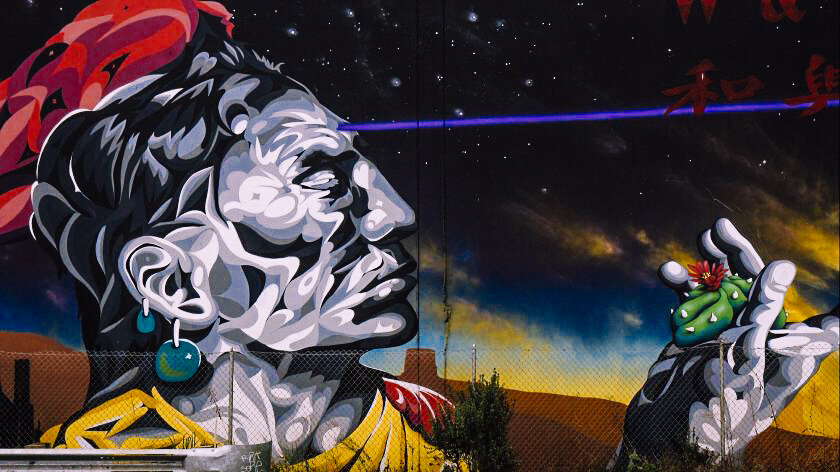Why Street Art in Public Space is Important to Health and Well-Being [Oakland CA]
One of the most breathtaking experiences I have had in a city was when I first witnessed Zio Ziegler's 6 story tall mural on the landmark Cathedral Building in Oakland CA. This kind, beautiful building stands at the convergence of Broadway and Telegraph Avenue. The City of Oakland's Cultural Arts Program and Downtown Improvement District, helped to support the creation of this mural to celebrate the exploding art scene in Oakland as well as the United Nation's 70th anniversary.
Within cities, streets and public open spaces should provide an opportunity for cultural expression through art and public demonstration. Streets comprise more than 80% of public space in cities. As such, they should be viewed as linear civic spaces and expose the community to engaging art in an informal setting. Ziegler's mural is visible at a community or city scale as opposed to other murals throughout Oakland that are of a neighborhood and human scale. It offers an awe inspiring contribution to the city's skyline and public realm. I was lifted out of my daily routine as I noticed the layering of textures and vibrant colors above the fabric of Broadway's main street buildings. I smiled as if witnessing a rainbow in the sky. The pops of color surprised me. Particularly, since the other three sides of the building are cladded with lovely, earth-tone terracotta, and the Gothic details provide balance, rhythm and order adjacent to the street. When we come across public art, we are often overcome with a feeling of being awed. As it turns out, the feeling we experience can actually boost our body's defense systems.




















The Cathedral Building's multicolored mural is of a human figure with a raised arm upon which a dove (the U.N.'s symbol of peace) is perched. A flock of doves rises from below the figure, and a splash of vivid, intricate patterns cover the figure's legs and torso. Similar to the activist art in Balmy Alley, this art also addressees political and social topics. According to the artist, the figure is both mother nature and the woman down the street. Her face is covered in a flesh tone checkerboard pattern, suggesting a range of varying, human skin tones. The rich patterns and textures playfully represent different subcultures within Oakland. The painting as a whole represents the causes the United Nations fights for, spotlighting the need to balance change and equality in a community that is economically and culturally diverse. Each subculture in Oakland has its own spatial territory, and each has created its own distinct life style. They are welcoming and small enough that the community has access to the full variety of life styles present in the city. This offers people an opportunity to choose a way of life and built environment they wish to live in. This is observed through communal support and shared values within each subculture. As individuals, our character evolves within environments that are unique and cohesive. We choose our actions based on what we believe is right as opposed to the way it has always been. We become whole because of communal support, chance social interaction as well as a shared sense of joy and purpose. Through our own self, we are able to publicly demonstrate what we stand for, our shortcomings and the ways we are trying to change them. By understanding the joyful value of a vibrant public realm, we can see that variety, character and finding our own self are closely interwoven.









The streets of Oakland are filled with more than 1,000 multi-color murals making the city itself a museum filled with sensory abundance! This offers the community access to art and creative expression without the cost barriers associated with museums and galleries. Oakland's murals promote a sense of identity, attachment, and openness. They also strengthen communal identification to public spaces. Public art offers many positive benefits to our mental health and well-being. It promotes equitable outcomes for historically disadvantaged populations. It can have therapeutic benefits for the mentally-ill and homeless populations. And further, public art has the ability to reduce stress. A study published in the Journal of Holistic Healthcare found that when participants walked and viewed art during their lunch break, there was a significant reduction in their cortisol levels. Cortisol is the brain's chemical responsible for stress. The reduction of cortisol was so drastic within the 40 minute lunch break that it would have taken a minimum of 5 hours to achieve the same decrease through other stress reducing activities.
![Why Street Art in Public Space is Important to Health and Well-Being [Oakland CA]](https://images.squarespace-cdn.com/content/v1/5b63c07485ede1aa9c4b6ced/1568584045607-ZNFLPNJ51789T2LAUIEU/Oakland+Street+Art_Joyful+Urbanist_Reduced.jpg)

![How Play Forms Joyful Threads That Link Us To Great Places [Barcelona]](https://images.squarespace-cdn.com/content/v1/5b63c07485ede1aa9c4b6ced/1578953271430-02L6LBG64TMQMNHKCOPF/Joyful+Urbanist_Las+Ramblas+Barcelona.jpg)
![Why Street Art in Public Space Kindles Communal Joy and Compassion [Balmy Alley San Francisco]](https://images.squarespace-cdn.com/content/v1/5b63c07485ede1aa9c4b6ced/1561269173160-1XRJONPJYNWOIX2M4WRK/Balmy+Alley_Joyful+Urbanist_Reduced.jpg)